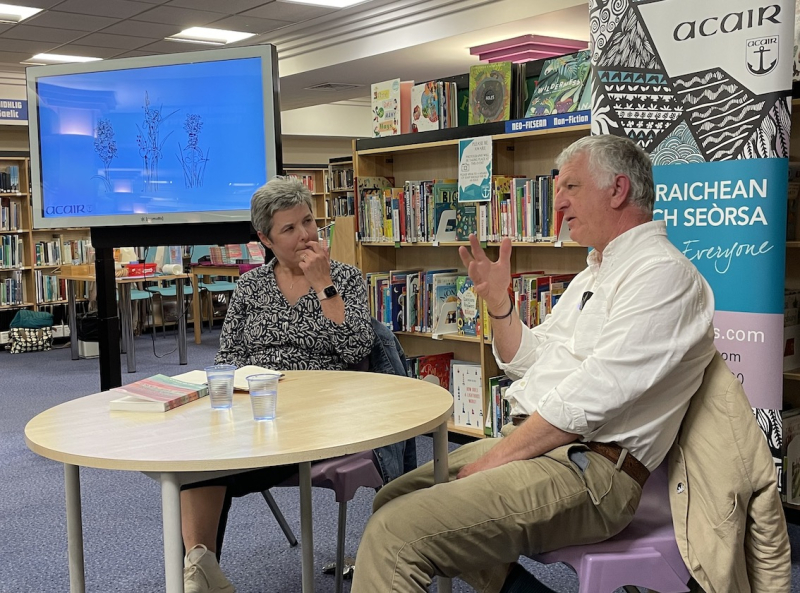
Introducing Frank Rennie and his new book, Among the Layers of the Land, at Stornoway Library on Friday, 5 July, Angus Morrison, manager of publisher Acair, pointed out that he hadn’t known there was going to be a General Election when putting the date for the launch in the diary.
But, despite the overnight distractions, a crowd gathered to hear the author in conversation with Annella Macleod.
Among the Layers of the Land considers the different ways that we look at the natural environment, celebrating our relationship with landscape and place. Through an unusual mix of non-fiction and short stories, it seeks to answer the question of what makes a place special.
“The book is essentially, for me, about how we think about the land,” Rennie told the audience, explaining that he had opted to include fiction as well as non-fiction because anything is doable in fiction. “The sky’s the limit,” he said.
Annella Macleod’s first question for the author, who has penned some 40 books including two for Acair, addressed the central question in Among the Layers of the Land about how a place comes to be special.
“It’s different for everyone,” Rennie replied, “because it’s the topography, it’s the feel of the place, it’s the memory, the associations, the culture, the heritage.”
The Galson-based author, who claims hardly to leave this home village these days, also suggested that knowledge, for example of history or the meaning of place names, can increase a person’s feeling for a place. That place needn’t be rural, he later elaborated in answer to a question from the audience, though for him it is.
Perhaps as result, he now has many trigger words. “The older you get, the more you accumulate,” he explained. One is remote when used to describe this place; another is bleak as applied to the North Lewis moor.
“I’ve stood in a hotel room in London looking out the window with nothing but concrete from horizon to horizon. That is bleak, my friend. That is barren. The moor is full of wildlife. It’s full of stories.”
Rennie, a retired professor of sustainable rural development at the University of the Highlands and Islands, went on to explain that Among the Layers of the Land had come about partly from spending time in one place during lockdown.
“We were fortunate. We had acres and acres of land. We could walk and see neighbours at a distance. That got me thinking about place. Walking the same route day by day, you see different things.”
The book’s title derives from Rennie’s keen interest in geology. He professed never to go anywhere without looking at the geology, starting to process it and wondering what’s below the surface and how it got where it is.
“To me, it’s a multi-layered way of looking at the land,” he said. “And, in some cases, I feel I almost enter into the land.”
Rennie also spoke about the things we can’t see – some of which are made apparent by new technology. LiDAR maps, for example, which are based on data obtained by satellites and have now been digitised by the National Library of Scotland, can show you things on a map that you can’t see when you’re standing on them, such as disruptions to drainage patterns.

This has led to the discovery of phenomena, such as bog breathing, whereby the bog expands and contracts depending on how much water it is holding. This can be measured from space to within a millimetre and shown on maps, which aids ecology.
“I find that quite ironic,” Rennie said. “At the same time that we’re understanding that topography and that ecology in more and more detail, which is useful, obviously, we’re also losing, one the other hand, placenames and understanding of anecdotes and stories.”
Together with Rennie’s previous book for Acair, The Changing Outer Hebrides, which won the 2020 Highland Book Prize, Among the Layers of the Land may perhaps be viewed in part as a contribution to the preservation and understanding of those precious resources.
Among the Layers of the Land costs £14 and is available from Acair and bookshops. Line drawings by Fiona Rennie complement the text. Creative Scotland supported the book’s publication. All royalties from the book are being donated to The Linda Norgrove Foundation, which supports women and children in Afghanistan.





